Volvo Trucks
 | |
| Subsidiary of the Volvo Group | |
| Industry | Automotive |
| Founded | 1928 |
| Headquarters | Gothenburg, Sweden |
Areas served | Worldwide |
Key people |
|
| Brands | |
| Revenue |
|
|
| |
Number of employees | 52,154 (2016)[1] |
| Parent | Volvo |
| Website |
volvotrucks |
_(2).jpg)
Volvo Trucks (Swedish: Volvo Lastvagnar) (stylized as VOLVO) is a global truck manufacturer based in Gothenburg, Sweden, owned by AB Volvo. In 2016, it was the world’s second largest manufacturer of heavy-duty trucks.[1]
Volvo Group was reorganized on January 1, 2012[2] and as a part of the process, Volvo Trucks ceased to be a separate company and was instead incorporated into Volvo Group Trucks, with Volvo’s other truck brands, Renault Trucks, Mack Trucks and UD Trucks.
The first Volvo truck rolled off the production lines in 1928, and in 2016 Volvo Trucks employed more than 52,000 people around the world. With global headquarters in Gothenburg, Sweden, Volvo manufactures and assembles its trucks in eight wholly owned assembly plants and nine factories owned by local interests.[3] Volvo Trucks produces and sells over 190,000 units annually.[1]
In 2017 chinese group Geely become first shareholder of Volvo Trucks [4]
History
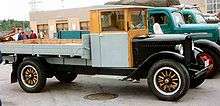
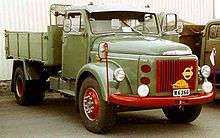
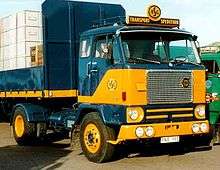
When Volvo manufactured its first automobiles in 1927, the first truck was already on the drawing table. In early 1928, the LV series 1 was presented to the public. Though by modern standards it was merely a truck, it was an immediate success and 500 units were sold before the summer. It had a 2.0 L 4-cylinder engine rated at 28 hp (21 kW).[5]
Volvo Trucks worldwide
Volvo cabs are manufactured in the north of Sweden in Umeå and in Ghent, Belgium, while the engines are made in the central town of Skövde. Among some smaller facilities, Volvo has assembly plants in Sweden (Gothenburg - also the Head Office), Belgium, USA, Brazil, South Africa, Australia, China, India and Russia. Some of the smaller factories are jointly owned. Its main parts distribution centre is located in Ghent, Belgium. The sales side, with their corresponding offices and dealers, is split into seven sales areas – Latin America, North America, Europe North, Europe South, Africa/Middle East, and Asia/Oceania.[6]
Production facilities
Plants where Volvo trucks are manufactured:[7]
- New River Valley, Mack Truck Macungie, Dublin, Virginia, USA
- Curitiba, Brazil
- Umeå, Sweden
- Gothenburg, Sweden
- Ghent, Belgium
- Kaluga, Russia
- Durban, South Africa
- Bangalore, India
- Bangkok, Thailand
- Brisbane, Australia
- Casablanca, Morocco
- Tunis, Tunisia
- Jeddah, Saudi Arabia
- Tehran, Iran
- Kuala Lumpur, Malaysia
- Wuhan, China
- Taipei, Taiwan
North America
The purchase of White Trucks in 1980 turned out to be a very good step for Volvo. Suddenly, Volvo's trucks could be marketed throughout the United States, in parallel with a tailor-made programme of modern American heavy-duty trucks. When Volvo took over the truck assets of White, the White/Autocar/Western Star product programme consisted of the Road Boss (conventional) truck, the Road Commander 2 (cab-over engine) truck, the low-built Road Xpeditor 2 (cab-over engine) truck, the Autocar DC (heavy duty construction) truck, the Road Constructor 2 (construction) truck and the Western Star (long-distance conventional and cab-over engine) trucks.
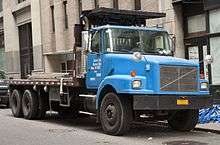
During the 1980s, improved versions of these trucks were introduced, including the Integral Sleeper (1982) long-distance truck, the Conventional (1983) upgraded conventional truck, the Autocar DS (1984) successor to the Road Constructor 2, the Integral Tall Sleeper (1985) truck which was the 'Globetrotter' of America, the aerodynamic 'Aero' (1987) truck, the Autocar (1987) construction truck with the option of using an integrated driveline (engine+gearbox+rear axle) designed and produced by Volvo and the short conventional WG (1988) truck.
Throughout the 1980s, Volvo produced White and Autocar, as well as distributing European-made Volvos. The White high cab-over-engine model was also badged a Western Star and sold through that company's Canadian dealer network.[8]
On August 16, 1986, General Motors announced that heavy duty truck manufacturing in Pontiac, Michigan would be discontinued and that GM's American and Canadian large truck operations would be joined with the Greensboro, North Carolina-based Volvo White Truck Corporation by 1988. The new company, based in Greensboro, was called Volvo GM Heavy Truck Corporation[9] and began marketing the Volvo White GMC badge, although all of the legacy GMC product lines had been discontinued by 1990.
In 1997, the Volvo White GMC name was discontinued, and all models were badged either Volvo or Autocar, which that year celebrated its 100th year in operation.
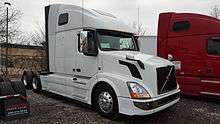
In a merger announced April 25, 2000, Volvo acquired Renault Véhicules Industriels, including Mack Trucks in North America.[10] The deal made Volvo Group the second largest truck manufacturer in the world, and the largest in Europe. In order to secure the approval of the authorities to proceed with the merger, Volvo had to agree to divest of its low-cab-over (LCOE) models, known as the Xpeditor range,[11] due to the degree the combination of this product with the Mack MR and LE series dominated the refuse markets in which these vehicles are predominantly used. Volvo re-entered the LCF market in 2007 with the purchase of UD Nissan Diesel.[12][13]
As a result of this ruling Volvo divested the Xpeditor product and the rights to the Autocar trademark in 2001. The purchaser was Grand Vehicle Works LLC,[14] a private holding company headquartered in Chicago that also owned auto industry pioneer Union City Body Company (founded in 1898) and Workhorse Custom Chassis.[15] Shortly before Autocar was taken over by GVW Group, Volvo phased out the remaining Autocar conventional products.
In 2009, Volvo began to relocate the operations of its Mack Trucks subsidiary to Greensboro, where the North American operations of Volvo Trucks have been headquartered.[16]
Today, Volvo produces class 8 Volvo trucks at its Dublin, Virginia plant and class 8 Mack truck models in Macungie, Pennsylvania. Affiliate Volvo Powertrain produces engines and transmissions at its Hagerstown, Maryland, facility, for use exclusively in the North American market.
Export markets
Volvo Trucks are exported to and sold by more than 1800 dealers in more than 75 countries.[1]
Failed radication in Argentina
Volvo tried to settle in Argentina on two different occasions: the first, in 1959 [17] would be carried out in partnership with the local company Conarg. The truck production was a failure, but some models of motor graders with Volvo engine was made by Conarg (under licence of Bolinder Munktell).[18] The second, in 1972, Volvo Sudamericana SACI has elevated to the consideration of the highest authority of the Ministry of Industry and Mining its project of installation of an industrial complex, consisting of an automotive terminal plant for chassis of heavy trucks with cab and chassis for long distance buses; a plant for trailers and a third plant for coaches.[19] In conclusion, Volvo loses the tender, which was in the hands of Scania.
Volvo product range
As a part of adapting to the new European Union Euro 6 engine environment requirements, Volvo Trucks renewed their truck range in 2012 and 2013. The biggest launch was the new Volvo FH in September 2012[20] The rest of the range were renewed in the spring of 2013.
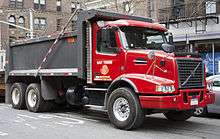
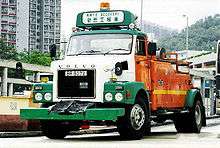
_2001.11.21.jpg)
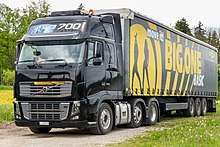
Current product line-up (as of May 2013)[21]
- Volvo FL
- markets - Europe, Middle East
- Volvo FE
- markets - Europe, Middle East, Australia
- Volvo FM, classic and new (launched April, 2013)
- markets - Europe, Africa, Asia, South America, Oceania
- Volvo FH, classic and new (launched September, 2012)
- markets - Europe, Africa, Asia, South America, Oceania
- Volvo FH16, classic and new (launched September, 2012)
- markets - Europe, Africa, Asia, South America, Oceania
- Volvo FMX, classic and new (launched April, 2013)
- markets - Europe, Africa, Asia, South America, Oceania
- Volvo VHD
- markets - North America, Mexico
- Volvo VNL
- markets - North America, Mexico
- Volvo VNM
- markets - North America, Mexico
- Volvo VNR
- markets - North America, Mexico
- Volvo VNX (announced March, 2013[22])
- markets - North America
- Volvo VM
- markets - South America
Past products
1920s |
1930s |
1940s |
1950s
|
1960s |
1970s
|
1980s
|
1990s
|
2000s
- FH12 and FH16
- Volvo 80th Anniversary FH & FH16
- Volvo VN and NH
- Volvo FM9 and FM12
- Volvo FL6
- Volvo VT (based on the VN)
- Volvo VHD
See also
- Autocar Company, former Volvo truck business
- Dynafleet, transport information system
References
- 1 2 3 4 5 6 "Annual and Sustainability Report 2016" (PDF). Volvo. pp. 8, 81, 88, 89.
- ↑ http://fleetowner.com/management/news/volvo-group-truck-business-1004
- ↑ http://www.volvotrucks.com/en-en/about-us.html
- ↑ {{http://www.chinadaily.com.cn/a/201712/28/WS5a443294a31008cf16da3e0e.html}}
- ↑ . - Volvo Trucks History. - Retrieved: 2012-01-09
- ↑ . - Volvo Trucks Dealers. - Retrieved: 2012-01-09
- ↑ . - Manufacturing worldwide. - Retrieved: 2012-01-09
- ↑ . - Volvo Trucks History, White. - Retrieved: 2012-01-09
- ↑ "G.M., Volvo Set Truck Linkup". New York Times. 1986-08-17. Retrieved 2009-10-15.
- ↑ "Volvo, Renault link trucks". CNNMoney. 2000-04-25. Retrieved 2009-10-15.
- ↑ "U.S. Competition Authority Gives Clearance To AB VOLVO'S Acquisition Of Renault V.I./MACK". Automotive Intelligence News. 2000-12-19. Retrieved 2009-10-15.
- ↑ "Volvo - press release". Cision Wire. Archived from the original on 2009-07-08. Retrieved 2006-03-21.
- ↑ "Volvo - press release". Cision Wire. Archived from the original on 2012-07-22. Retrieved 2007-03-24.
- ↑ "Volvo - press release". Cision Wire. Retrieved 2001-07-26.
- ↑ http://www.gvwgroup.com
- ↑ Barron, Richard M. (2009-09-04). "Mack Moves South: Bulldog in Tow". News & Record. Archived from the original on 2012-09-05. Retrieved 2009-09-04.
- ↑ http://camionargentino.blogspot.com.ar/2012/09/primera-radicacion-fallida-de-volvo-1959.html
- ↑ http://pesadosargentinos.blogspot.com.ar/2015/09/bolinder-conarg-vhk-100.html
- ↑ http://camionargentino.blogspot.com.ar/2012/08/no-pudieron-ser-radicacion-de-volvo-en.html
- ↑ . - News article - Retrieved: 2013-05-07
- ↑ Volvo Trucks Global. "Volvo Trucks product line-up -Retrieved: 2012-01-09". Volvo.com. Retrieved 2012-01-09.
- ↑ . - Press release - Retrieved: 2013-05-07
External links
| Wikimedia Commons has media related to Volvo Trucks. |
